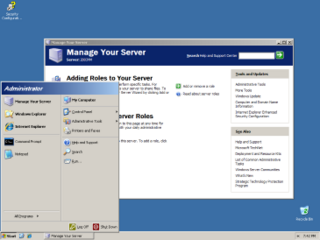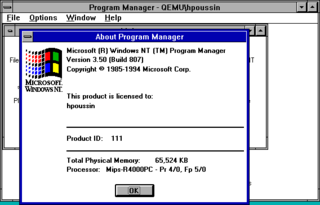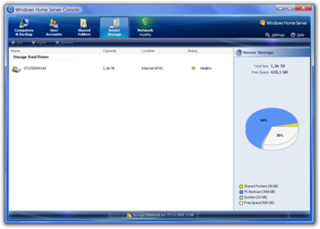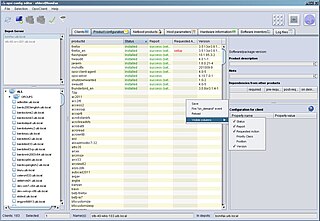Related Research Articles

Windows 2000 is a business-oriented operating system that was produced by Microsoft and was released as part of the Windows NT family of operating systems. It was succeeded by Windows XP in 2001, releasing to manufacturing on December 15, 1999 and being officially released to retail on February 17, 2000. It is the successor to Windows NT 4.0.
In computing, iSCSI is an acronym for Internet Small Computer Systems Interface, an Internet Protocol (IP)-based storage networking standard for linking data storage facilities. It provides block-level access to storage devices by carrying SCSI commands over a TCP/IP network. iSCSI is used to facilitate data transfers over intranets and to manage storage over long distances. It can be used to transmit data over local area networks (LANs), wide area networks (WANs), or the Internet and can enable location-independent data storage and retrieval.

Windows Server 2003 is a server operating system produced by Microsoft as part of the Windows NT family of operating systems and released on April 24, 2003. It is derived from the Windows XP operating system. It is the successor to Windows 2000 Server and the predecessor to Windows Server 2008. An updated version, Windows Server 2003 R2, was released to manufacturing on December 6, 2005. Windows Server 2003's kernel was later adopted in the development of Windows Vista.
The Bootstrap Protocol (BOOTP) is a computer networking protocol used in Internet Protocol networks to automatically assign an IP address to network devices from a configuration server. The BOOTP was originally defined in RFC 951.

In computing, the Preboot eXecution Environment, PXE specification describes a standardized client–server environment that boots a software assembly, retrieved from a network, on PXE-enabled clients. On the client side it requires only a PXE-capable network interface controller (NIC), and uses a small set of industry-standard network protocols such as DHCP and TFTP.
Microsoft Exchange Server is a mail server and calendaring server developed by Microsoft. It runs exclusively on Windows Server operating systems.
Linux Terminal Server Project (LTSP) is a free and open source terminal server for Linux that allows many people to simultaneously use the same computer. Applications run on the server with a terminal known as a thin client handling input and output. Generally, terminals are low-powered, lack a hard disk and are quieter and more reliable than desktop computers because they do not have any moving parts.

Windows NT 3.5 is an operating system developed by Microsoft, released on September 21, 1994. It is the second release of Windows NT.

A diskless node is a workstation or personal computer without disk drives, which employs network booting to load its operating system from a server.

Windows Preinstallation Environment is a lightweight version of Windows used for the deployment of PCs, workstations, and servers, or troubleshooting an operating system while it is offline. It is intended to replace MS-DOS boot disks and can be booted via USB flash drive, PXE, iPXE, CD-ROM, or hard disk. Traditionally used by large corporations and OEMs, it is now widely available free of charge via Windows Assessment and Deployment Kit (WADK).

DRBL is a NFS-/NIS server providing a diskless or systemless environment for client machines.
Network Access Protection (NAP) is a Microsoft technology for controlling network access of a computer, based on its health. With NAP, system administrators of an organization can define policies for system health requirements. Examples of system health requirements are whether the computer has the most recent operating system updates installed, whether the computer has the latest version of the anti-virus software signature, or whether the computer has a host-based firewall installed and enabled. Computers with a NAP client will have their health status evaluated upon establishing a network connection. NAP can restrict or deny network access to the computers that are not in compliance with the defined health requirements.
NetBoot was a technology from Apple which enabled Macs with capable firmware to boot from a network, rather than a local hard disk or optical disc drive. NetBoot is a derived work from the Bootstrap Protocol (BOOTP), and is similar in concept to the Preboot Execution Environment. The technology was announced as a part of the original version of Mac OS X Server at Macworld Expo on 5 January 1999. NetBoot has continued to be a core systems management technology for Apple, and has been adapted to support modern Mac Intel machines. NetBoot, USB, and FireWire are some of the external volume options for Mac OS re-install. NetBoot is not supported on newer Macs with T2 security chip or Apple Silicon.
The Windows NT startup process is the process by which Windows NT 4.0, Windows 2000, Windows XP and Windows Server 2003 operating systems initialize. In Windows Vista and later, this process has changed significantly; see Windows Vista startup process for information about what has changed.
Network booting, shortened netboot, is the process of booting a computer from a network rather than a local drive. This method of booting can be used by routers, diskless workstations and centrally managed computers such as public computers at libraries and schools.

Windows Home Server is a home server operating system from Microsoft. It was announced on 7 January 2007 at the Consumer Electronics Show by Bill Gates, released to manufacturing on 16 July 2007 and officially released on 4 November 2007.
Windows Vista contains a range of new technologies and features that are intended to help network administrators and power users better manage their systems. Notable changes include a complete replacement of both the Windows Setup and the Windows startup processes, completely rewritten deployment mechanisms, new diagnostic and health monitoring tools such as random access memory diagnostic program, support for per-application Remote Desktop sessions, a completely new Task Scheduler, and a range of new Group Policy settings covering many of the features new to Windows Vista. Subsystem for UNIX Applications, which provides a POSIX-compatible environment is also introduced.
Windows Deployment Services is a server technology from Microsoft for network-based installation of Windows operating systems. It is the successor to Remote Installation Services. WDS is intended to be used for remotely deploying Windows Vista, Windows 7, Windows 8, Windows 10, Windows Server 2008, Windows Server 2012 and Windows Server 2016, but also supports other operating systems because unlike its predecessor RIS, which was a method of automating the installation process, WDS uses disk imaging, in particular the Windows Imaging Format (WIM). WDS is included as a Server Role in all 32-bit and 64-bit versions of Windows Server 2008, and is included as an optionally installable component with Windows Server 2003 Service Pack 2.

AnywhereTS is a software thin client solution for Microsoft Windows.

Opsi is a software distribution and management system for Microsoft Windows clients, based on GNU/Linux servers. Opsi is developed and maintained by uib GmbH from Mainz, Germany. The main parts of Opsi are open-source licensed under the GNU Affero General Public License.
References
- 1 2 "Remote Installation Services". Microsoft. Retrieved 2012-07-03.
- ↑ Unable to Create Windows 2000 Server Image on RIS Server prior to SP3
- ↑ Service overview and network port requirements for the Windows Server system Microsoft Inc.
- ↑ "Software Distribution". Dell KACE. Archived from the original on 2015-10-03. Retrieved 2012-07-06.